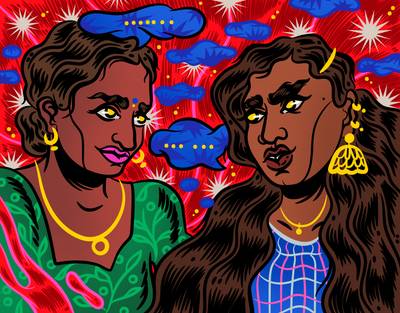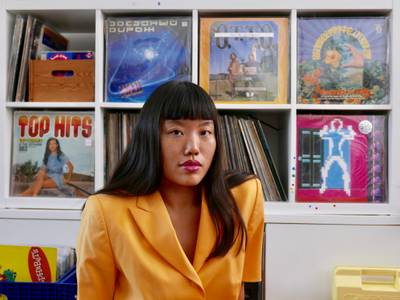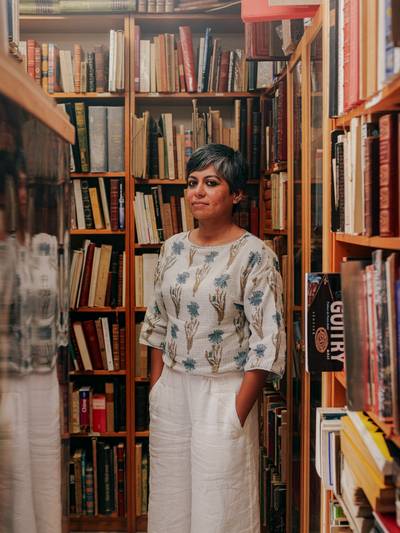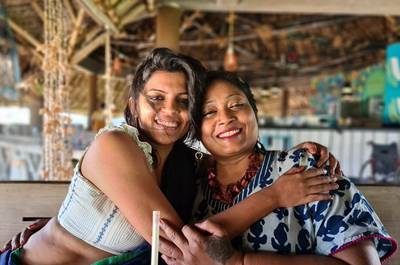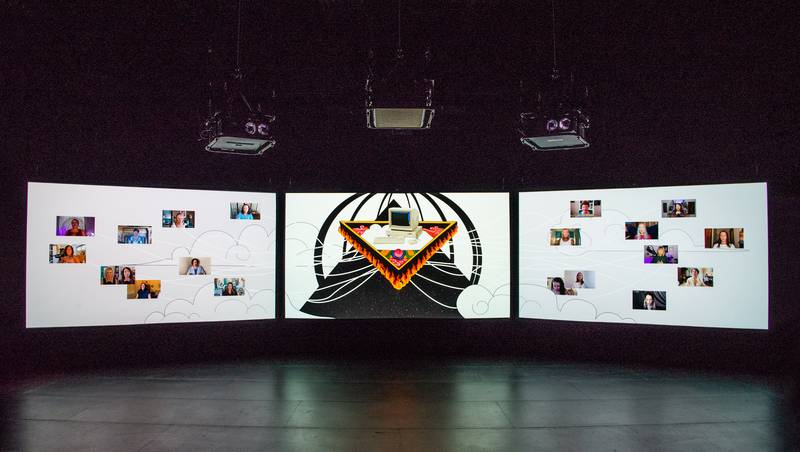

Voices Installation at BAM Brooklyn, photo by Marion Aguas, 2025
Margarita Athanasiou is an artist based in Athens, Greece. Her practice is text-based, utilises collage techniques, and brings together autobiography and history to create multi-layered narratives in the form of publications, video essays, prints, memes, and digital images.
Lorena Juan is the current artistic director of the Freiburg Biennale. She was the exhibition curator of the Transmediale festival 20-24. In her curatorial practice, she works with experimental formats, public space, and collaborative processes. As a researcher, Lorena Juan focuses on practices in art and activism that emerge from queer feminist collectivity. She is co-founder of Coven Berlin, a queer feminist online platform.
Voices (2024) is a multi-channel video essay by artist Margarita Athanasiou that traces the intertwined histories of mediumship, technology, and female agency. Combining archival footage, family recordings, and digital collage, the forty-three-minute work reimagines channeling and possession as both spiritual and political gestures. During the nineteenth and twentieth centuries in the West, such technologies of voice allowed several women to speak publicly by claiming that they were merely transmitting messages from elsewhere.
The film moves between centuries and registers: nineteenth-century séances, twentieth century New Age movements, and contemporary digital culture. Its fractured body of images is held together by a disembodied narrator — at once omniscient and intimate — whose voice slips between archive, memory, and speculation.
Drawing from personal and inherited rituals of listening and transmission, Athanasiou approaches channeling as a method of research and self-making, a way to attend to what remains inaudible. Voices treats the body as an instrument of transmission, an interface through which stories, desires, and ghosts circulate. The result is an unstable cosmology of voices that blur the line between belief and authorship, revealing how history itself might speak through us.
With Voices as a starting point, curator Lorena Juan and artist Margarita Athanasiou exchanged letters on feminist technologies, matrilinear rituals, and friendships across time. Their letters have been edited for this publication.


Voices Installation at BAM Brooklyn, 2025
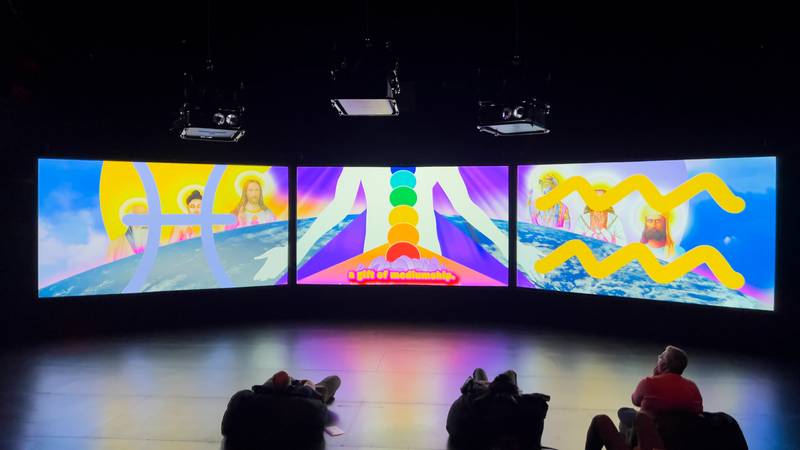

Voices Installation at BAM Brooklyn, photo by Mathew N, 2025
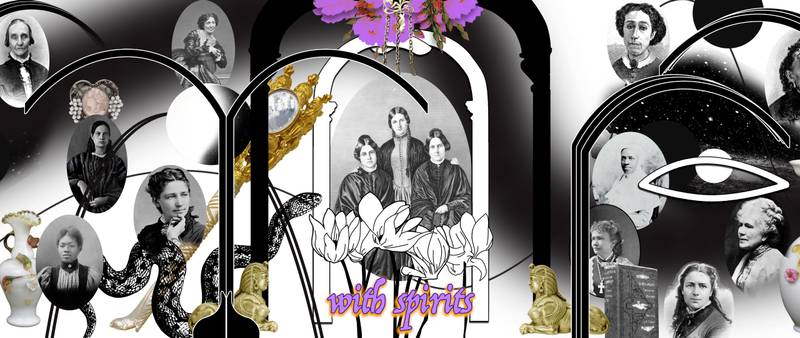

Voices, Still image, 2025
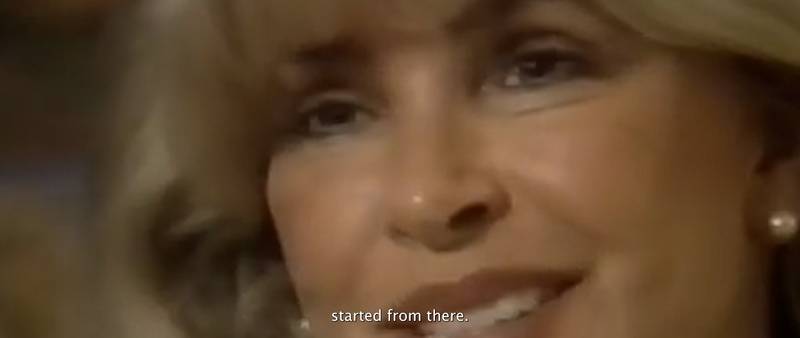

Voices, Still image, 2025
LORENA: Dear Margarita,
I’ve been sitting with your work, Voices. I am watching it several times, tracing the patterns as they shift between testimony, archive, essay, and ritual. In its complexity, the work resists linear interpretation and instead unfolds like a constellation to me: associations over arguments, frequencies over facts. There’s a lot I want to explore, especially how it navigates the entangled histories of mediumship and media, spirituality and systems.
The opening scene stays with me: you and your mother channeling together. She is repeating the messages. As a child, you are writing them down. The ritual feels both intimate and defiant. Encouraging you to trust yourself, saying things that are rarely said so directly to girls, but through the “voice” of the spirits, they could be said. Heard. Believed. Would you say that those early rituals shape how you approach collaboration now — with editors, archives, and technologies?
MARGARITA: Dear Lorena,
These experiments took place over a short period of time, but they did have an impact on me. They gave me a sense of curiosity and the need to have first-hand access to the information. I guess they made me want to work on my own if anything.
Lorena: Voices also made me think of ventriloquism — not as a stage trick, but as a survival strategy. The way a voice can travel through another body, disguised, deflected, safe—that strange loophole: divine voice as feminist technology. As the piece wonderfully shows, 19th-century Spiritualism created unexpected public platforms for women, allowing them to speak with authority by claiming it wasn’t they who were speaking at all. Séances are both mystic and political events. A way of saying: what I feel matters, even if the world says otherwise. Voices hold that tension so well — never ironic, never naive. You trust the earnestness of belief, even when it’s messy, borrowed, or full of static. Sometimes I wonder if your editing acts like channeling too — listening for what’s already there but still inaudible.
M: Interesting, there was actually a part in the script that talked about editing, which I took out later. See here:


Screenshot of an earlier draft of the script for Voices
The way I work is very intuitive and hands-on. Despite only using digital technologies, making these collages bears something of the physicality of cut and paste in a scrapbook. I always start with the text; a lot of editing is involved there, and then at some point, I begin visualising the words. I don’t tell the stories visually; these video essays are very much narrated texts. When the visual aspect starts coming in, I also start getting acquainted with the story. My editing is textual, and much like you are describing it, it’s a way of chiseling away to reveal the story.
L: I kept thinking about how those same energies ripple through the present — especially in queer communities. The way astrology, tarot, divination, and channeling have become not just aesthetic but ways of thinking and feeling. I see it so much in queer circles — not as a trend exactly, but as a language, a world-building kit. A way to check in with yourself and others. To hold complexity. It makes me wonder what it is about these practices that draws us in, again and again. Or maybe, what kind of permission does the spirit world offer that the real one doesn’t?
M: Thank you for your words. I am writing to you from the island of Lesbos now. The word “permission” stayed with me the most. In Voices, I tell many stories to talk about a single thing, which is the coming of age. Sometimes this method feels like instrumentalising, others like making friends across time, and others like unraveling an invisible thread of meaning that holds the universe together — a romantic conspiracy. These stories are, in reality, fragments of stories that belong to other people. Women who had an urge to speak, to teach, to contribute to what each thought was a great political and spiritual shift in their time, but nothing around them supported them. The spirits filled the gap in their surroundings, and this internalised masculine voice offered authority directed both ways, towards the individual, enabling them and the crowd she addresses, legitimising them.
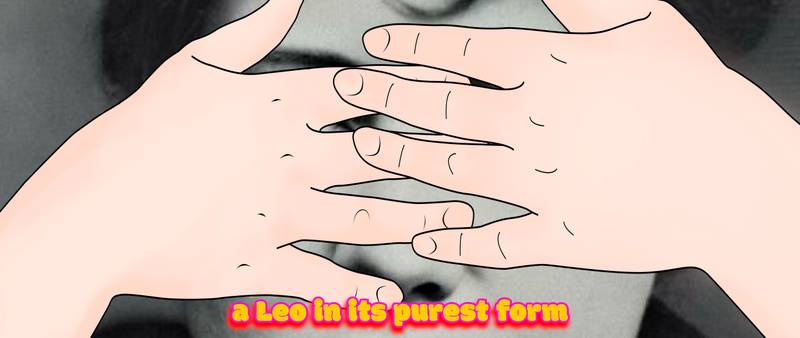

Voices, Still image, 2025
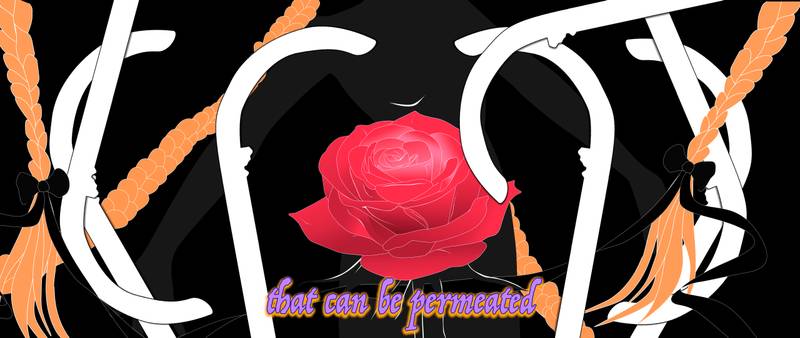

Voices, Still image, 2025
The eighth chapter of Voices is titled “celestial meet-cutes”; it’s all about these spirits suddenly (and serendipitously) entering the lives of women in a time of great personal crisis, changing their fate forever. Not unlike in pulp romance novels, where the charming man appears right when all hope for love is lost, this repeated event mirrors a biblical theophaneia. It is the moment of collision between the mundane and the extrasensory from which the individual can never return the same. In Voices, this is the moment permission is finally granted.
For me, this work, in the long, long years I worked on it, became in itself a possession ritual reenacting the channeling experiments I did as a kid. I was moved by how you described them. Whilst I was making Voices, I slowly permitted myself to become the voice that used to appear to tell us everything will be fine, the disembodied narrator. This is a technique I playfully borrowed from traditional documentaries, the all-knowing narrator not unlike the embodied voice of the many spirits that appear in this story – cuts across the work, and the digital collage becomes a fully fleshed frankensteinian body. To me, this is the body of the medium.
Gemini sun, Pisces moon, and Scorpio rising here 👐 .
L: Gemini sun, Pisces moon, Scorpio rising — of course you’d end up making a (long, long) film reclaiming channeling as a feminist practice! Re-watching the eighth chapter of Voices, a Gloria Anzaldúa poem came to mind, and I wanted to share it with you—it’s a love poem for an alien girlfriend. Tender, funny, erotic, it’s about learning to love someone who doesn’t fit into human categories. The narrator oscillates between teaching her lover the “right” way to be and celebrating her strangeness. Permission flows both ways—the human offering access, the alien granting permission to imagine otherwise.
It made me think about ghosts versus aliens as companions. A ghost connects backward to memory and inheritance. An alien looks forward, toward futures we don’t yet know how to live or speak. Maybe your disembodied narrator sits in between—ghostly with the past, alien with the promise of what’s still to come. A benign spirit built on many “self-granted permissions” that defied the sanctioned script.
I love how you describe Voices as weaving many stories to illuminate a single theme. It captures the tension between multiplicity and focus, between the weight of each story and the larger tapestry they form together. Your honesty about storytelling — the way it can feel like “instrumentalising,” yet also like forming alliances across time — is deeply important. It reminds me that writing (or making films) is never neutral: it is an act of care, curiosity, and responsibility.
I’d love to know if the Anzaldúa poem resonates with your research. Also, would you rather have an alien or a ghost as a lover? Are you in Lesbos? Can you share pictures?
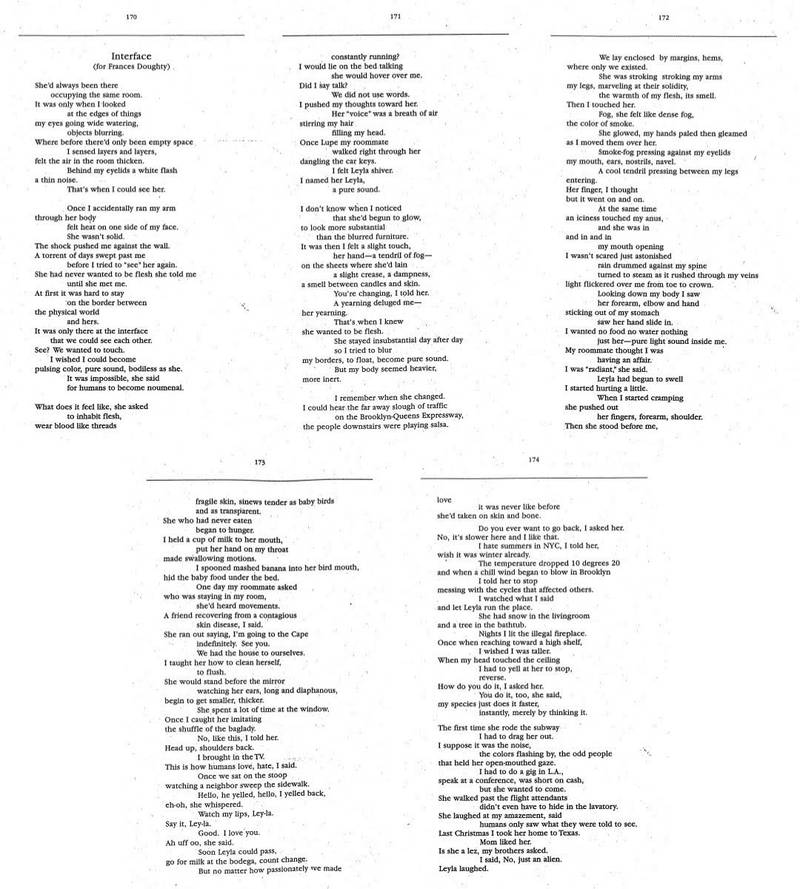

Interface (for Frances Dougherty) by Gloria Anzaldúa
M: Lesbos was a present and a curse. A trip in all the meanings of the word. It unfolded like a story, and I am back in Athens, trying to untangle it. Do you ever do that? Look for a story in the everyday. I am not sure how healthy it is. I guess the narrative of Voices is constructed in this way because I live my life in a quest for quests. It is the practice of making the world smaller and more exciting. And a practice of disembodiment. Like the alien girlfriend :)
The Anzaldua poem really got to me, actually. Thank you for sharing. It moved me. It does resonate with aspects of the work, about a love that emerges seemingly out of thin air, but actually out of one’s own body.
When I was a kid, there were these “Unexplained” magazines lying around in our house. They were full of alien theories, ancient secrets, and hollow earth conspiracies. In one of the issues, there was a story about two people who, while astral projecting, came across each other in the astral plane and became lovers there. I was obsessed with it. I dreamt of having a disembodied lover when I grew up. Or maybe of becoming one? Maybe that is the dream, to be the alien girlfriend, the one who points to the future. To be honest, I do wish for an alien girlfriend. My experience with ghosts has not been the best. Very Pisces moon.
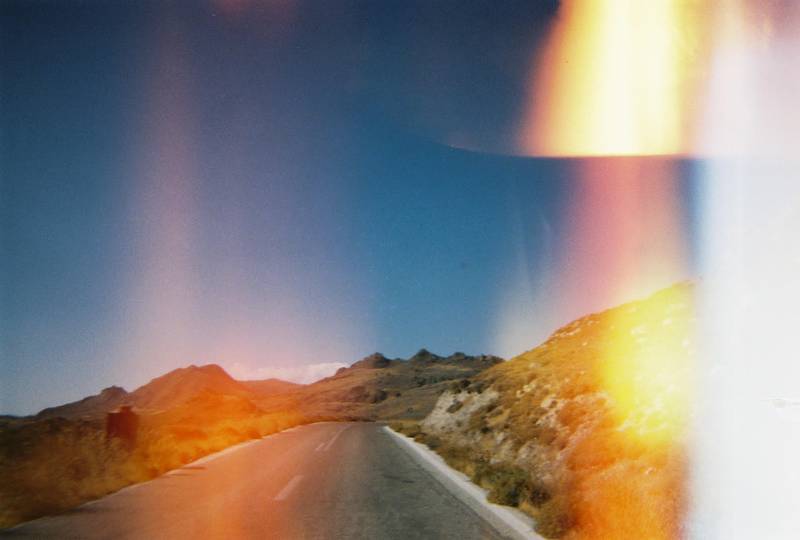

Photograph of the island of Lesbos
L: Your answer about the alien girlfriend brings to mind the life-long queer question: do I want to be like her or do I want to be her? Mediums and channels may have solved it long ago. They get to be both, the muse and the artist, the message and the messenger. I’m so bad at choosing myself, so maybe not an alien or a ghost, what about a shapeshifter alien ghost?
I loved the astral projecting lovers’ story; I would have obsessed over it as well as a child! What can be more romantic than that? In this way, to fall in love on another plane is also to admit that love is always partly elsewhere, never fully contained in the realm of tangible things, far away from bills, relatives, and deadlines… It is indeed a queer love story — one that folds time in on itself. Do you see Voices as a kind of love story, too, maybe between selves or worlds?
M: If we are talking about genres, for me, Voices is a coming of age story. I have this peculiar relationship with “filmmaker’s filmmaking" if that makes sense. It’s a world I don’t belong to, but I like referring to it. I think of my works in terms of genres playfully. I don’t necessarily talk about that, but it’s important for me in the writing stage. While scripting this, I knew it was an abstracted coming of age tale. It was unashamedly about empowerment and embracing an impossible version of oneself. This is where the Sailor Moon stuff comes in.
In the third chapter of the work, I talk about the Magical Girl narrative genre in anime. In these animes, the girls are passing through five stages to transform from regular girl to magical girl. It is a motif I noticed while reading medium and channeler autobiographies for research. The women I refer to in the work described their own transformations from regular women to beings with a mystical purpose in very similar stages, so I purposefully developed Voices’ narrative to mirror this structure. And romance absolutely plays a part! Sailor Moon must love Tuxedo Mask, right?
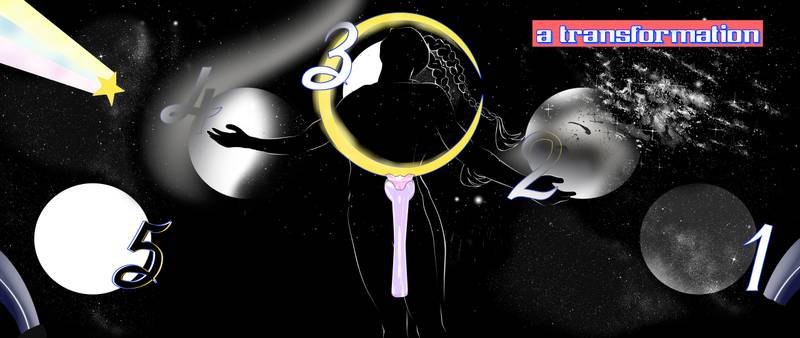

Voices, Still image, 2025
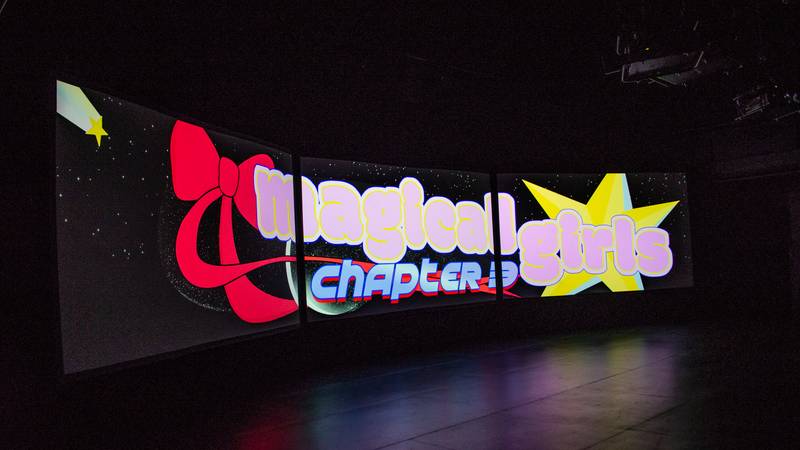

Voices Installation at BAM Brooklyn, photo by Marion Aguas, 2025
Bringing fantasy elements into the text was a conscious move. In fantasy, we are allowed to suspend our disbeliefs. I used this as a vehicle to allow my audience to relax into this otherwise more essayistic story. It is a way of dealing with the question — but is it real? Did they really believe they were talking to otherworldly entities? I wanted to create a space for play, joy, and lightness.
The question of love really interests me. There is something both erotic and gender-bending and gender-role-bending about these “celestial meet-cutes”. It was important for me to explore these more transgressive aspects of the transformation process. I wanted to create connections between romantic love and the divine love we often hear about — the connection with other worlds. Love is often talked about as a tool in spiritual practices. For even in christianity they talk about having a personal relationship with Jesus. Love is a central theme in the work, but to me, it is still not a love story.
Funnily enough, the film essay I am developing now, I think of as a love story. In an abstracted way, of course, but still, it is an impossible romance about alchemy and the rise of fascism. This game around genres allows me to set conceptual margins around the work. Even the wildest of quests for quests need some narrative boundaries.
L: What you wrote about living “in a quest for quests” immediately made me think of the ending of Voices. After channeling so many other lives and longings in the film, you return to your own voice, admitting your wish, like them, to know that you’re on the right path, that there’s a future already mapped out for you. It feels like the same impulse: weaving every fragment into a meaningful story, a life worthy of living. The road in Lesbos you sent me seems to hold that paradox too. You choose one path among many, but why we choose some paths over others is indeed still Unexplained.
Maybe someday we will come across a copy that tells us how the story ends.
With loving interferences,
Your Aries sun, Cap moon, Virgo rising,
Lorena
